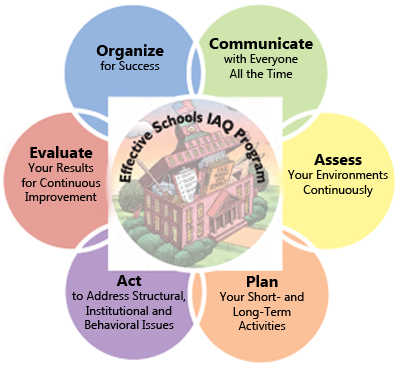Managing Radon in Schools
- The Indoor Air Quality Tools for Schools Approach: Key Drivers and Strategies for Success
- Key Drivers for Success and Strategies in Action
- Links and Resources
The Indoor Air Quality Tools for Schools Approach: Key Drivers and Strategies for Success

Successful school IAQ management programs are works in progress, and most districts put the components of success in place over time. The"Framework for Effective School IAQ Management: Key Drivers" is a system enhanced by continuous reinforcement. Implementation of one Key Driver will support and contribute to the development of another.
Strategies that support the Key Drivers complement this positive feedback loop. Overall program efficiency increases as school districts incorporate each Key Driver into their programs. This document describes how the "Framework for Effective School IAQ Management: Key Drivers" displayed in the graphic on the right (click on each of the circles to find more information) can help schools address radon risks as part of a comprehensive IAQ management process.
Successful IAQ management in schools comprises effective pollution source control. Radon — a radioactive gas — is one of the most hazardous indoor pollutants. Radon is the leading cause of lung cancer among non-smokers. In the U.S., an estimated 20,000 people die from radon-induced lung cancer annually. Thousands of classrooms nationwide have elevated radon levels, needlessly exposing hundreds of thousands of students and staff to this serious health risk.
EPA recommends testing all schools for radon. As part of an effective IAQ management program, schools can take simple steps to test for radon and reduce risks to occupants if high radon levels are found. The only way to know if elevated radon levels are present is to test. Many schools have successfully applied radon mitigation strategies to control indoor radon levels.
Radon gas enters from the soil beneath the school through cracks and openings in the foundation. Air pressure inside a building is sometimes lower than pressure in the soil under the foundation. Because of this difference in pressure, a building acts like a vacuum, drawing radon inside from the soil. Typical cracks and openings include joints where the floor meets the wall, expansion joints in the floor, openings in the floor for pipes and wires, and hollow masonry walls that penetrate the floor.
EPA offers detailed guidance on radon testing, results interpretation and mitigation in schools. Also, the IAQ Design Tools for Schools provides guidance on how to control radon in renovation and construction projects and how to manage radon risks during repair, renovation and maintenance of existing facilities.
Key Drivers for Success & Strategies in Action
Organize for Success
Secure Senior Buy-In: Ensure senior-level support. Encourage administrators and facilities managers to connect with radon professionals to share their stories and solicit advice. Partner with parent groups, local health departments, facilities and maintenance organizations and other credible organizations to build understanding, trust and support.
Develop a Systematic Approach:Use the IAQ Tools for Schools Action Kit to tie your goals for radon testing to your overarching IAQ, health and environmental program goals. Coordinate this effort with existing IAQ management program activities.
Build an Effective Team:Assemble a multidisciplinary team to plan for radon testing and mitigation. Include on your team a trained radon professional; start by talking with your state radon program representative. Invite members from existing IAQ or Health and Safety Committees, facilities managers, air-conditioning technicians, IAQ professionals, school administrators, other staff and parents.
Design Standard Operating Procedures, or SOPs:Develop district-wide radon management procedures and adapt testing protocols and remedial action steps according to the needs of each school.
Communicate with Everyone All the Time
Make the Radon Program Meaningful: Include radon awareness as part of your overall IAQ management training and education efforts. Share with parents and staff the link between radon and building operations, and encourage them to test their homes as the home is often the most significant source of radon exposure.
Be Transparent and Inclusive: Communicate your action plan to stakeholders and the importance of radon testing. Share your testing results, mitigation plans and follow-up testing plans. In cases of elevated radon levels, ensure that your mitigation plan is in place so you can communicate those plans to parents. Invite key stakeholders to examine the issue and be part of the solution.
Assess Your Environments
Walk the Grounds:Perform radon assessments in conjunction with your regular IAQ walkthroughs. Obtain floor plans to estimate the number of test kits needed and to determine where to place the test kits. If elevated radon levels are found, survey your buildings for structural or mechanical issues that could be allowing radon to enter, such as cracks in the foundation, expansion joints, subslab HVAC ducts and building pressurization patterns.
Use Technology:Track radon test results, assessment data and pending actions on a spreadsheet or in an electronic work order system to build awareness of emerging priorities so that facility maintenance can plan accordingly.
Plan Your Short- and Long-Term Activities
Work in Stages:Working with your radon team, identify your action steps and set a schedule for your testing plan. Determine what type of test kits to use and which rooms will be tested. Your state radon program can help you identify next steps and offer other guidance throughout the process of testing and mitigation.
Prioritize Actions: Identify funding and staff resources available for testing and mitigation. If mitigation is necessary, then initiate radon reduction in the highest radon risk areas first.
Act to Address Structural, Institutional and Behavioral Issues
Test for Radon:Test according to your plan. Refer to Radon Measurement in Schools: Revised Edition EPA 402-R-92-014, for more detail. EPA suggests initial short-term testing in all frequently occupied, ground contact rooms.
Implement Radon Reduction Plans:If you find high radon levels and need to mitigate, consider hiring a mitigation contractor. Some states have restrictions on who can test or mitigate a school. Consult with your state radon office for state-specific recommendations.
Train Occupants to Identify Radon Risks:Attend radon training to learn about radon and how to effectively test, mitigate and maintain radon reduction. Empower maintenance and facilities staff to become radon champions as occupants will likely refer to them for answers about the testing plan and mitigation actions.
Educate Staff about Radon:Include teachers in your testing process to foster awareness and create support. Encourage them to incorporate radon into lesson plans by having students participate in radon-related science projects or in the National Radon Poster Contest.
Evaluate Your Results for Continuous Improvement
Solicit Feedback:Ask for feedback from your radon testing team, district stakeholders and parents to improve the radon management process. Identify best practices that improve your process for future follow-up radon testing.
Ensure Continuity of Radon Management Plan: Determine additional testing needs and follow-up. Retest according to plan if schools were mitigated to ensure radon mitigation systems are functioning properly. Schedule re-testing following all major renovations, and consider how HVAC modifications or upgrades may affect radon intrusion.
Links and Resources
- Visit EPA's Radon home page for facts, discussion points, and frequently asked questions and answers.
- Find EPA's Radon guidance for schools.
- Contact your state radon office for state-specific recommendations, see our list of state contacts.
- Connect with radon professionals and solicit advice at EPA's Radon Leaders webpage.
- Read about the National Radon Poster Contest; get announcements and read about the rules at the National Radon Program Services website. Exit
- Read guidance on the IAQ Design Tools for Schools webpage.
- TheIAQ Tools for SchoolsAction Kit provides best practices, industry guidelines, sample policies and a sample IAQ management plan to improve school air at little or no cost.

